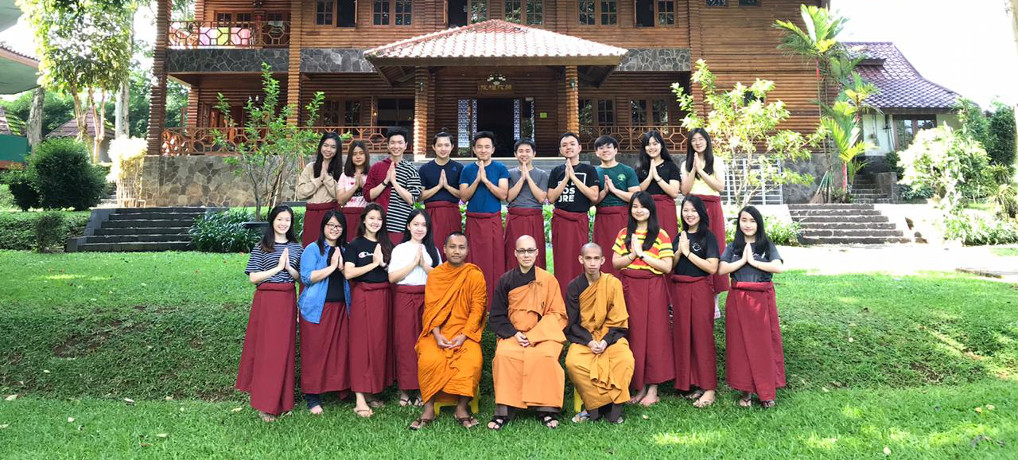
Here I am, a year later, sitting on the same exact spot writing about the same event and yet a whole different experience. KMVB UPH hosted another event called ‘Fun with Dhamma’ with the emphasis on ‘Finding Peace within You.’ Because I attended the last event, consciously I have made some expectations and was hoping that this time will be as good as last year’s. Fortunately, the event was as expected and yet, another eye-opening experience for me.
It was the same routine of meditation but, somehow the experience was different. As if there will always be something new to discover and explore. Be it with the practice, or within yourself. So, the fact that I attended the last event does not really matter because I experienced a whole another experience.
In one of the Dhamma Sharing session, a friend asked about sitting meditation and how to deal with the cries of our legs and feet. With enthusiasm and a bit of humor, Bhante Kirya answered, “Feel it, feel the pain, feel where the pain comes from. The pain will always be there but it is always up to you whether you want to suffer or not.” It opened a whole new perspective regarding my aching legs and feet. What he said makes total sense, pain and suffering are two different objects and we can separate one from the other.
With that new, interesting knowledge in my mind, I set a resolution that I will try to sit thirty minutes without moving at all. Interestingly enough, I did it. Despite the constant struggle and battle inside my mind, I managed to persevere through the pain and decided not to suffer. During the thirty minutes, I kept thinking if my blood stopped flowing and my legs cant feel anything, does my legs need to be amputated? Those thoughts constantly tested my resolution but now I can finally say that indeed, there can be pain and no suffering.
In another session of Questions and Answers with the monastics, my other friend asked a question that piqued the interest of Bhante Nyanabhadra; the question was so long that in one question there were four questions. It was regarding self-love, hopelessness, self-hate, and ways to overcome them. In the case of self-love, he simply answered, “Taking enough sleep is loving yourself, taking care of your body is loving yourself, eating the right food is loving yourself. These are the things that you are currently doing in this camp and these are the ways to love yourself.” So simple yet so profound.
In regards to hopelessness and self-hate, he told my friend that it is both a blessing and a curse that you were feeling this way at that point. A curse because you hate yourself but also a blessing because you admitted and acknowledged that there is self-hate. He continued, “Just like the Four Noble Truth, first, the acknowledgement of hating yourself. Second, find the reasons why you hate yourself. Thirdly, knowing the reasons will help you in overcoming your self-hate. Lastly, find the ways to overcome that suffering.”
His answer did not stop there, he began explaining, “Consistent practice of meditation and application of mindfulness can help and guide you, but of course to a certain extent. Eventually the that feeling will come back again and knock your door. But this time, you are more prepared in facing it. It is also impossible to avoid the problem and please do not try to avoid the problem because it will make you suffer more. Instead, acknowledge that feeling and embrace it and know that this will pass.”
When he finished talking, my friend started to tear up and Bhante Nyanabhadra was clueless on what he said wrong. I spontaneously said, “Its tears of happiness” and I hope it was.
Another perspective that amazes me was when Bhante Nyanabhadra was speaking about the shape and content of Buddhist teachings. He elucidated that there are many shapes of traditions of Buddhist teachings but essentially, the most important aspect is its content rather than the shape. Many people put significance on the shape but lose sight of the essence. As long as the content reflects the core of Buddhism principles, the shape is of secondary importance.
Previously, I said I gained a drop of enlightenment in the boundless ocean of Buddhist teachings and this time I can say I gained another priceless drop of enlightenment through this event. Although there are challenges and difficulties ahead of me, I am sure that with practicing these mindfulness methods will help me reach equanimity. Credits to the committees that made this whole thing happened and to my new Dharma friends. I hope we will cross each other’s paths again in the future.
Oleh: Hendy, Keluarga Mahasiswa Vidya Buddhis, Universitas Pelita Harapan.